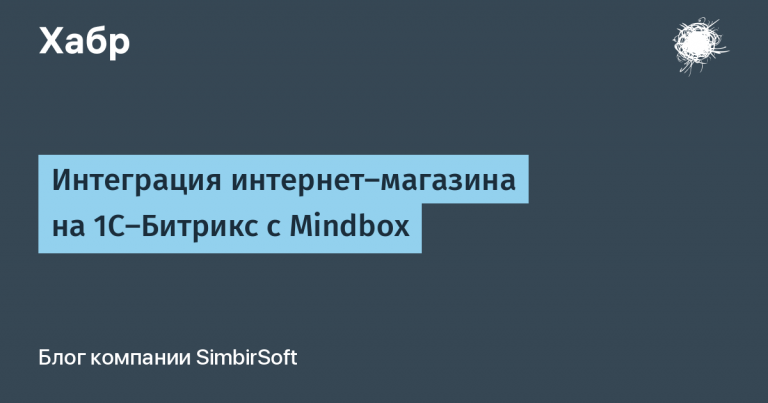Blade of Destiny (1992)

“…we aimed to make the most nerdy role-playing game of all time…”
“Modern games have spoiled players. I look forward to seeing players refuse to buy games that they can lose… The game must be challenging. I grew up playing arcade games, spending countless quarters trying to find ways to get past a particularly difficult area.” (From interview game creator Guido Henkel)
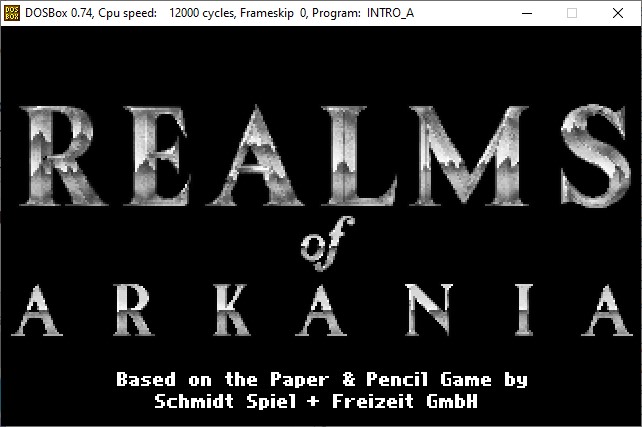
The computer role-playing game Realms of Arkania: Blade of Destiny was created by the German company Attic Entertainment Software, whose origins were Guido Henkel, Hans-Jurgen Brändle and Johan Hamma. Before starting work on Blade of Destiny, the company had already made several games. Including the role-playing game Spirit of Adventure, published by the German publisher Starbyte. The latter wanted Attic to create a game for them based on the Das Schwarze Auge board system. But the relationship with the publisher soured. According to Henkel StarByte “threw them to the money”. In the end, Henkel and his team managed to negotiate with the owner of Das Schwarze Auge to work on the game themselves, without the “spoiled” publisher. The game was created with its own funds, but the board game publisher, Fantasy Productions, helped with marketing. Blade of Destiny for MS-DOS and Amiga appeared on store shelves in 1992. After success in the local market, the game was translated into English and published by the legendary Sir-Tech in 1993.

Das Schwarze Augewhich means “Black Eye” in German, is the German answer to Dungeons & Dragons.
The first edition of this board was published in 1984, and the last, fifth, in 2015. They say that in Germany it is more popular than DnD. In terms of setting, as I understand it, this is a fairly typical fantasy with elves, dwarves and orcs. You may have heard about the game Drakensang (2008), she is also based on this board.
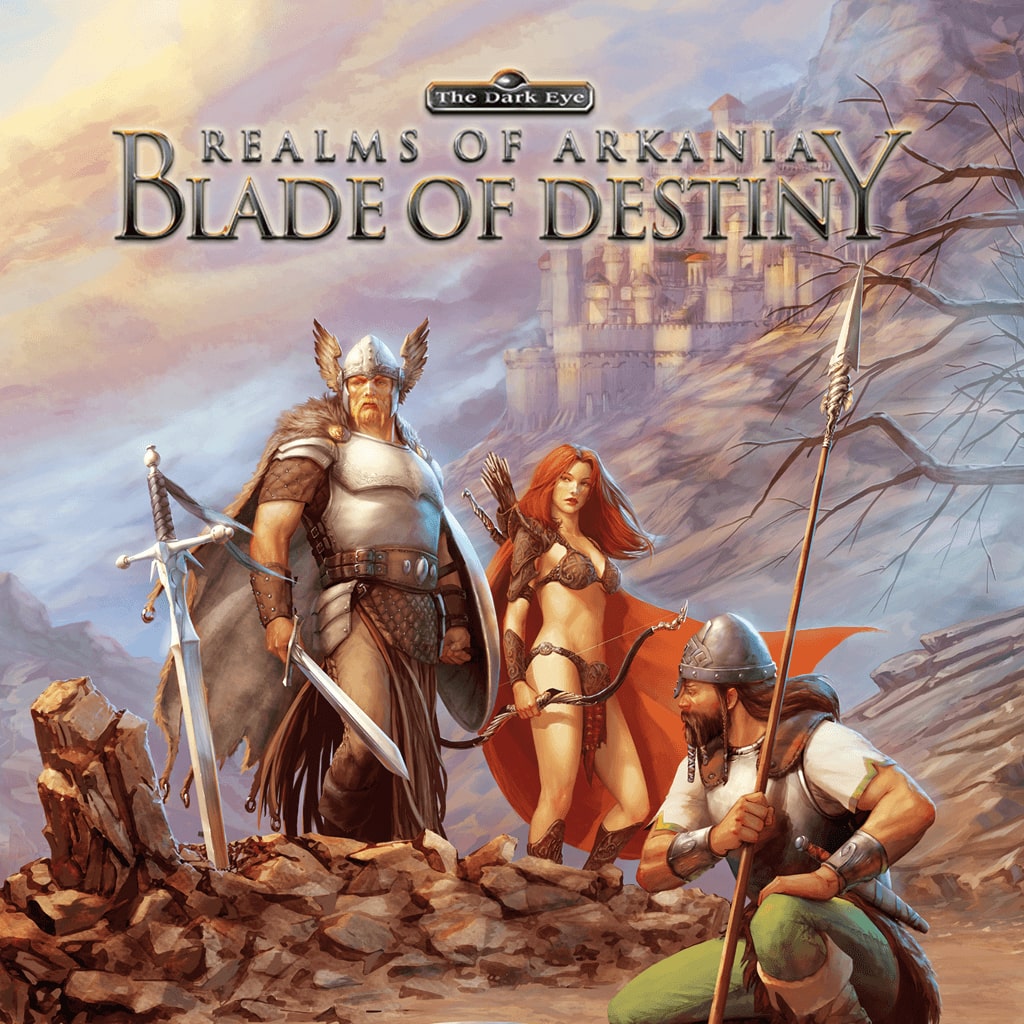
As you can understand from the epigraph, the guys sought to make Realms of Arkania: Blade of Destiny hardcore even for its time. In an interview with the creators, which can be found in the English Clue Book, they say: “In the beginning, of course, there was a question of what should take precedence; either a simple creation of a computer RPG with all its weaknesses, or a real conversion of an RPG to a computer. We decided to go the latter route because no one had done it before.”

A strong statement, isn't it? They continue: “Whenever an existing tabletop RPG is converted to software, it loses its most important qualities—vividness and detail. We decided to keep it all, although we knew full well that this would be an unusual, if not difficult, undertaking. But we wanted to make a computer RPG for real role-players. Technically, we began to implement all the rules and fundamentals of the system even before we started working on the plot.” This interview also notes that Hans-Jürgen Brendle played Das Schwarze Auge for years, and Guido Henkel only saw one play session before development began.

From introductory video, made in slightly funny graphics, we learn about the great commander Hyggelik, who, after one of his campaigns, went to the island of the Cyclops to forge a sword there that was legendary in its power. With this sword, he went to the lands of the ferocious orcs, who were harassing the inhabitants of the northern lands of Arkania with raids. But he did not return from there alive, and his sword was lost. As the intro says, this was in the past, and in the present, you, a group of adventurers, have arrived in the northern city of Torval in search of adventure and do not yet know anything about the sword of fate. You will find adventures. If you don't quit Blade of Destiny after the first thirty minutes.

I'll say a few words about the graphics. She's normal. VGA. The GOG version using DOS-box plays quite well. In 2013, a remake of Realms of Arkania: Blade of Destiny was released on Unity. And the graphics there seem to me… less pleasant than in the original. That is, technically, it is, of course, better in all respects. But from the point of view of banal aesthetics, it is terrible. The remake looks like a remaster of Skyrim, if some pervert made it overnight using the cheapest assets for Unity. I'll talk about the limitations of 1992 graphics later. For now I’ll just note that it suits me. Everything is visible, everything is distinguishable, you don’t need to look closely anywhere with a magnifying glass.
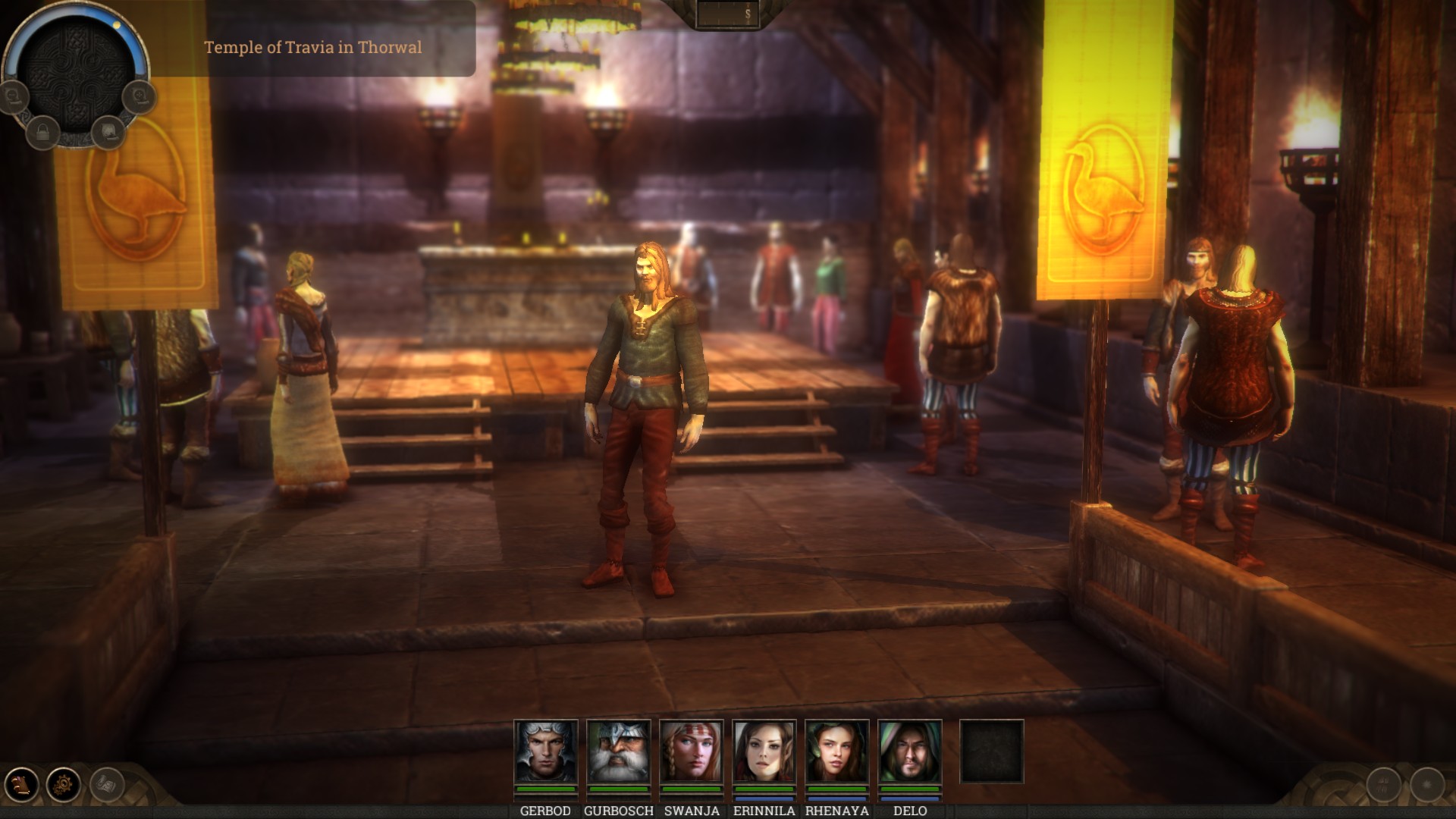
After launch, Blade of Destiny offers us to either create characters ourselves, or start the game with ready-made ones. There are also two difficulty modes: for beginners and advanced. The difference between them comes down only to the management of skills and spells, and not to the combat parameters or the complexity of the puzzles. In beginner mode, the computer decides for you which skills and spells to upgrade and in what volume. This mode is highly discouraged, not only because it takes away half the fun of playing an RPG, but also because the computer makes decisions worse than even an inexperienced player. In advanced mode, character creation is hardcore, just like the game itself. But it's interesting. In the remake, the procedure didn't change much.

Even in beginner mode we will have to deal with a lot of stats. The peculiarity of Realms of Arkania: Blade of Destiny is that there are not only positive stats, but also negative ones. There is also a very interesting and important detail – any skill and any spell is determined not by one stat, but by three at once. For example, the chance of a successful strike will be determined not just by strength… But by strength, courage and “speed”. Although, some craftsmen who took the game apartthey say that the manual is lying and in fact the calculation formula for an attack will consist of strength, speed and intuition, and not courage.

It doesn’t matter who is right, what matters is that several stats decide at once. It's difficult and interesting at the same time. More examples. The blinding spell “lightning” is determined by wisdom, intuition and “speed”. Yes, “speed”! Physical characteristics can be important for the use of magic, although not always. For the skill of theft, courage, intuition and dexterity are important to us. Great, right?

Let's look a little at the stats themselves. First the positive ones. A well-established translation from English is given. Courage determines the chance of a successful attack (in theory), magic resistance and the skills of the “body” group. Wisdom is one of the main stats for spellcasters, an analogue of intelligence in DnD. In addition to spells, it affects many skills and also defense against magic. Charisma is important for wizards and for social skills. Dexterity is needed by archers, wizards, and for many skills such as picking locks. “Speed” (Agility (flexibility?)) determines many skills and such important things as attack and parry indicators. Strength is one of the most important stats in the game. And not only for warriors. In addition to the accuracy of the strike, it affects a bunch of skills and “carrying capacity”. Depending on your strength and endurance, the number of movement points in battle will change. Intuition is something like Perception from DnD. Affects parry, magic and many skills. Very important for the party leader to find traps etc.

Now the negative ones. In principle, their essence is clear from their names. We have Superstition, Acrophobia, Claustrophobia, Avarice, Necrophobia, Curiosity, Violent Temper. I will not go into detail on each characteristic, since this is not a manual. I'll only tell you about a few. Superstition affects protection from magic. A high value will mean poor resistance to magic damage. Fear of heights can affect a character's behavior on a mountain route. Curiosity and stubbornness are supposed to come out in social situations.
There are derivatives from these stats, such as the number of hit points (health), magic resistance, movement points, and the basic chance of attack or parry success. I won't dwell on this.

Unlike Dungeons & Dragons, there are no classes or races in Das Schwarze Auge, there are only archetypes. In Realms of Arkania: Blade of Destiny, there are 12 archetypes available to us. Let's go through them briefly. We have a warrior, everything is clear with him. The dwarf is a tank familiar with picking locks. Thief, you can guess here too. The jester is the equivalent of a bard from DnD. The Torvalian is a kind of Viking warrior with, for some reason, a high vulnerability to magic. The Sorcerer, Druid, and Wizard are spellcasters, each with a specific spell specialization. The Hunter is the DnD equivalent of the Ranger. And we also have three archetypes of elves: “steppe”, “forest” and “northern” (Silvan, Green, Ice). Their differences between each other are not very great. They combine the properties of hunters and wizards.

So, creating characters is not easy. Each archetype has its own requirements for character attributes. So for a Torvalian we need values of 12 in Courage and 13 in Strength. And also at least 7 in Superstition. Moreover, in the original Blade of Destiny, this is not indicated anywhere in the game itself. You need to constantly look at the manual. This was simplified a bit in the remake. Of course, in a hardcore game you need to roll the dice. For each of the 14 attributes. When creating a new character, die roll values can range from 8 to 13 for positive attributes and from 2 to 8 for negative attributes.

Throwing the dice works like this. First, you “roll” the die and assign the resulting value to the attribute of your choice. For example, you roll a 13 and to create a Torvalian you assign that value to Strength. Then you get an 8 and you give it to charisma, which you don’t really need. And so on. The catch is that you can change the value of attributes only by resetting all values. If at the end of throwing the dice you understand that, well, you really don’t want to have a bad value for some negative stat, then in order to change it you will have to roll everything again, including positive stats. In fact, you can choose an archetype without rolling a die. The computer will select random values for you that satisfy a certain archetype. But the game warns you that such a character will be weaker than a hand-created one.

Next, you will need to decide on skills (skills) and spells (spells). This is where the fun begins. There are 52 skills and 85 spells in the game. It was very interesting for me to read about them in the manual and make the choice. The game has Combat skills, for example, sword and ax skills, Body skills (acrobatics, stealth), Arts skills (craftmanship: picking locks, healing wounds), Social skills (trade, seduction), knowledge skills (alchemy, languages) , Nature skills (knowledge of herbs, orientation) and Intuition skills, there are only two of them: sense of danger and perception.

There are 12 schools of magic in Realms of Arkania: Blade of Destiny. From the school of Treatment to the school of Domination. I will not dwell in detail on each of them, especially on each individual spell. The article has already become similar to a guide. Each spellcaster archetype is better at some spells and worse at others. Okay, I'll talk about a few spells as examples. Evil eye is a dominance spell. The enemy fascinated by it will take your side. The best thing about this spell is the Druid. Fiat Lux – creates magical light, which can be useful in dungeons. Refers to Elf spells. Transversalis – teleportation, allows the party to move behind walls, which is also very helpful in dungeons. Wizard's Spell.

Finally we get to the gameplay itself. We begin Blade of Destiny in the temple of the city of Torval. When moving inside locations such as cities and dungeons, as well as when visiting some places, such as temples and shops, a first-person view is used. And here it’s appropriate to talk about the graphical limitations of the 1992 game. The interior decoration of all temples, shops, hotels, taverns, forges, etc. absolutely the same. The herbalist's shop in the city of Torval will be absolutely identical to the herbalist's shop in the city of Prem. The temple of the hearth goddess Travia is no different from the temple of the water god Efferd. Externally, with the exception of temples, almost all houses look the same. There are only a few house models. The same applies to dungeons. The game has only two types of textures for dungeons and castles: blue and brown. Of course, extreme monotony does not make the game beautiful. In the remake, the quality of graphics has improved, but the architecture still remains monotonous.
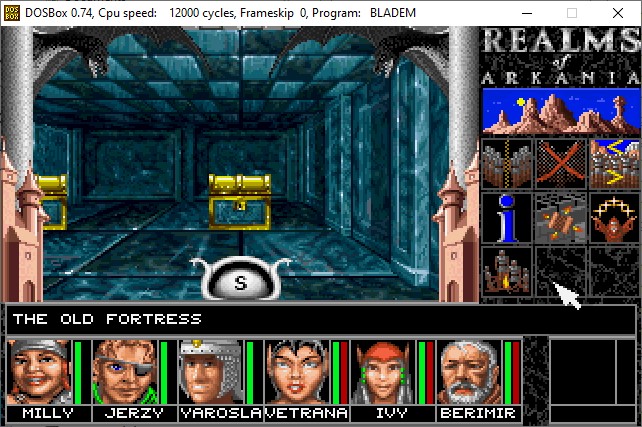
Many cities in Realms of Arkania: Blade of Destiny are simply gigantic. Now I wanted to count the exact number of houses in Torval or Fexkaer, but I lost count. There are more than a hundred of them in every city. It's rare that a game can boast something like this. At the beginning I was very attracted to this, such “realism”. In Torval you can find fourteen (14!) different taverns. Different stores have different prices, different taverns have different opening hours. Moreover, in different taverns you can hear different rumors! I was kicked out of one tavern in disgrace for cheating and was not allowed there again. Then it turned out that it was in this tavern that I was supposed to hear a story that gave an interesting side quest… Karma is a bitch.

In cities and dungeons, we also have access to a local map. This is a very useful thing due to the extremely monotonous textures of the locations. The different types of houses are highlighted in color on the map. For example, temples are indicated in orange. In dungeons, the stairs down are reflected in blue. Unfortunately, you cannot move around in map mode. Therefore, you have to constantly switch between the view from your eyes and the map. This flaw was eliminated in the remake.

Realms of Arkania: Blade of Destiny has an open world. Some time after the start of the game, you will receive a task that will become your main quest. You are free to choose which cities and in what order you will visit and whether you will visit at all. To move around the global map, you first need to find an exit point on the local map. After this, a map of northern Arkania will open, where you can move between nearby locations. Long-distance sea routes are available in some cities. By the way, the operation of the ports is also done realistically. Ports have their own opening hours, and on different days different routes are open to you, depending on which ships are sailing. Navigating the global map is what makes Blade of Destiny the original game. In addition to the usual random encounters, you will often have to make stops during your travels. Various mechanics are unlocked here. You can assign three sentries, preferably with improved intuition, to reduce the risk of a surprise attack by enemies. You can, and should, try to find water and hunt. Someone with a good knowledge of nature can go out and collect useful plants. Sometimes you will come across unmarked places on the map, such as a goblin cave or NPCs, with whom you can talk, sometimes even usefully.

In essence, the free exploration of the global map is what brightens the game the most and creates a feeling of real freedom and adventure. There are about 40 cities in Realms of Arkania: Blade of Destiny! And many more hidden locations. In the remake, the operation of the global map remains largely the same, but the need to find a specific exit point on the local map has been removed.

Before I talk about the combat mechanics, it is important to mention such a thing as diseases. Yes, you can get sick and die in Blade of Destiny. Got your feet wet while your characters were wading a river on the global map? You have a cold! An orc hit you with a rusty sword? Congratulations, you've caught tetanus! Diseases have to be treated either by doctors in cities, or independently with the help of herbs. You also need to drink and eat periodically. If such a game were released in modern times, they would probably say that it has “survival” elements.

In Blade of Destiny, when the battle begins, the view changes to an isometric camera, which shows all your characters and opponents from above, if the latter do not have reinforcements. Battle maps are quite large and can reach anywhere up to 24 cells on one side and about 18 on the other. But it happens that you have to fight in long but narrow corridors only a few cells wide. You can only move and attack in a straight line in the game. You can't do anything diagonally. This flaw was corrected in the remake. But, as they say, the battle as a whole did not become any better due to the appearance of other shortcomings. The range of actions for characters who do not possess magic is very small. Depending on your inventory weight and strength attribute, you have between 1 and 8 action points. They can be spent either on movement, one point per cell, or on attacks with melee or ranged weapons (3 points). You can use an inventory item, for example, a healing potion, this is also 3 points.

In essence, this is all that characters without magic can do. There are no tricks or perks for regular weapons. Each character has attack and parry stats with self-explanatory meanings. A character can only parry once per round. However, this also applies to opponents. Because of this, one of the main tactical tips is to surround the enemy. When attacking with a melee weapon, you can choose the nature of the attack: aggressive, standard and neat. The more aggressive the attack, the greater the chance of successfully defeating the enemy, but the lower the chance of you successfully parrying.
Spellcasters can spend 5 points to cast a spell. Different spells have different ranges. Some can be performed from any distance, while others require you to come close to the target.

This is where I will begin my story about my impressions of Realms of Arkania: Blade of Destiny and its shortcomings. Combat is the weakest component of the game. I expected very difficult and grueling battles from such a “hardcore” game with 85 spells. And they were exhausting, but they were not complex and interesting. The battles were difficult only at the beginning, and only because the first-level characters could do almost nothing. Many spells failed, and the warriors could not hit the target thirty times in a row. And this is not even an exaggeration about thirty times. Maybe even an understatement. The length of battles is one of the biggest problems with Blade of Destiny's combat system. Even at high levels, your characters take a very long time to hit the enemy. Despite the huge “geographical” expanses of the game, the set of opponents is not large; for most of the game you encounter the same enemies. There are almost no spellcasters among them. Without the opportunity to compete with enemy sorcerers, battles look very boring. And out of 85 spells, in fact it turns out that at best a third is needed in the game. So throughout the game you level up and use the same spells you find useful. Against this background, the number 85 ceases to look magical. Character leveling becomes boring when you spend experience points on the same skills and spells.
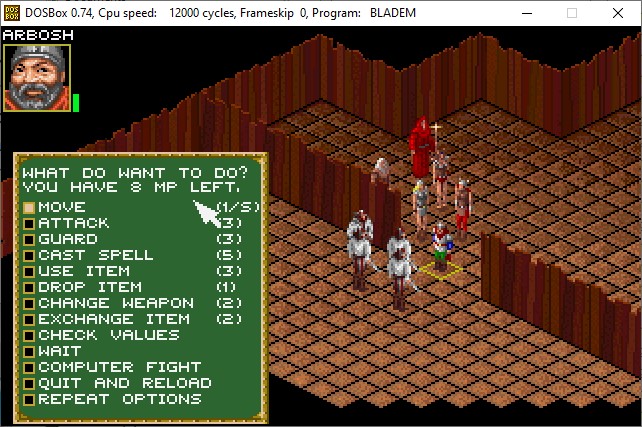
It is not clear why so many battles are fought against very small enemy forces. Here you have six characters, and they are opposed by a group of three bandits without magic skills. Again and again. Again and again. Towards the end of Blade of Destiny, I got tired of clicking on the same thing 50 times to get past the next pair of orcs, and started using the computer automatic battle mode. In this mode, you have two options: allow your heroes to use magic or not. In principle, most battles are completed successfully in automatic mode. Its main drawback is the AI sends your spellcasters and archers into close combat. So after the autopilot you have to treat them. Nevertheless, I completed the vast majority of battles at the end of the game in computer mode, simply because it is much faster.

I wrote about the fact that at the beginning I was pleasantly surprised by the filling of cities and the variety of activities while traveling around the global map. By the end of the game, the cities and travel also left me terribly tired. Imagine that in a city of 100 houses you need to find an important NPC to complete the main quest. All the houses are the same, both as seen from the eye and on the local map. You literally need to poke around in every house for a long time to find the one you need. If, for example, you need a forge, but it is on the other side of the city, then you also need to look for it for a long time. As a result, by the end of the game I began to be lazy and peek at the Clue Book, where there are maps of cities, in order to at least roughly know where the healer I needed, say, was.

Stopping once or twice, looking for grass, hunting, setting up a patrol – it’s all fun at first. But if you need to walk very long distances in the same places in search of a certain location, then this also becomes extremely tedious. Clicking the same buttons over and over again to restore your water supply is terribly boring. And random battles only make the situation worse. I'm sorry I did that. I think that the mindset of a modern player, accustomed to quick rewards, still has an effect. But at the end of the game I also went into the walkthrough to find one place on the global map. Instead of wandering around it for another hour. I'm sorry, but the fact remains that after a while moving around the global map also gets boring.

In an interview with Guido Henkel said: “It seemed to us that no one before us had managed to make an accurate adaptation of a board game for the computer – and that’s exactly what we were striving for. We wanted the computer version to have all the nuances of the desktop game. We succeeded, however, the result appealed only to the hardcore fans of the genre.” But he also said that “…fun is more important than mechanics. There's no point in making boring games. They must engage, entertain, and challenge the player's actions and thinking.”

In my opinion, the main problem with Realms of Arkania: Blade of Destiny is that it is boring. And it definitely failed to convey “all the nuances of the board game.” The vast majority of skills in this game are useless. The game has a riding skill, but no horses. There is a skill of seduction, but there is no one to seduce. As I already said, many spells are also essentially useless. The “liveness and details” that Guido spoke about are precisely what the game lacks. Alas. The creators can be justified by the fact that the game was prepared as the first part of a trilogy. And perhaps there was an intention to realize the benefits of these skills in the following parts. I haven’t played them yet, but, as they write, many skills remain unnecessary there. The vast majority of cities don't have any interesting NPCs to use your social skills on. Dialogues are not something that shines in Blade of Destiny at all.

I forgot to write about one of the main advantages of the game. These are dungeons, many of them are made with many levels, traps and sometimes interesting puzzles.
The soundtrack in the game is nothing special and for some reason CD quality is only available in the German version.
If you know English, you can read what they wrote in gaming magazines about Blade of Destiny at the time. In general, the game was received lukewarmly, but some journalists had high hopes for subsequent installments.

By the way, I myself first wanted to play Realms of Arkania: Star Trail 1994 Because this game is praised by many people. But I decided to read the first part anyway. And I didn't regret it. Yes, the game has many shortcomings. And the ambitious authors clearly did not manage to realize everything they wanted. Nevertheless, the game turned out to be good and original. But its sequel is considered more successful.

Regarding the remake, I didn’t go through it, I just got acquainted with it. Overall I have a bad impression. The graphics, although technically better, are not pleasing to the eye at all. And in return for the old shortcomings, as they say, many new ones have appeared. Now the remake seems to have been completed, but it came out terribly buggy and even ended up in list of the worst games in history!
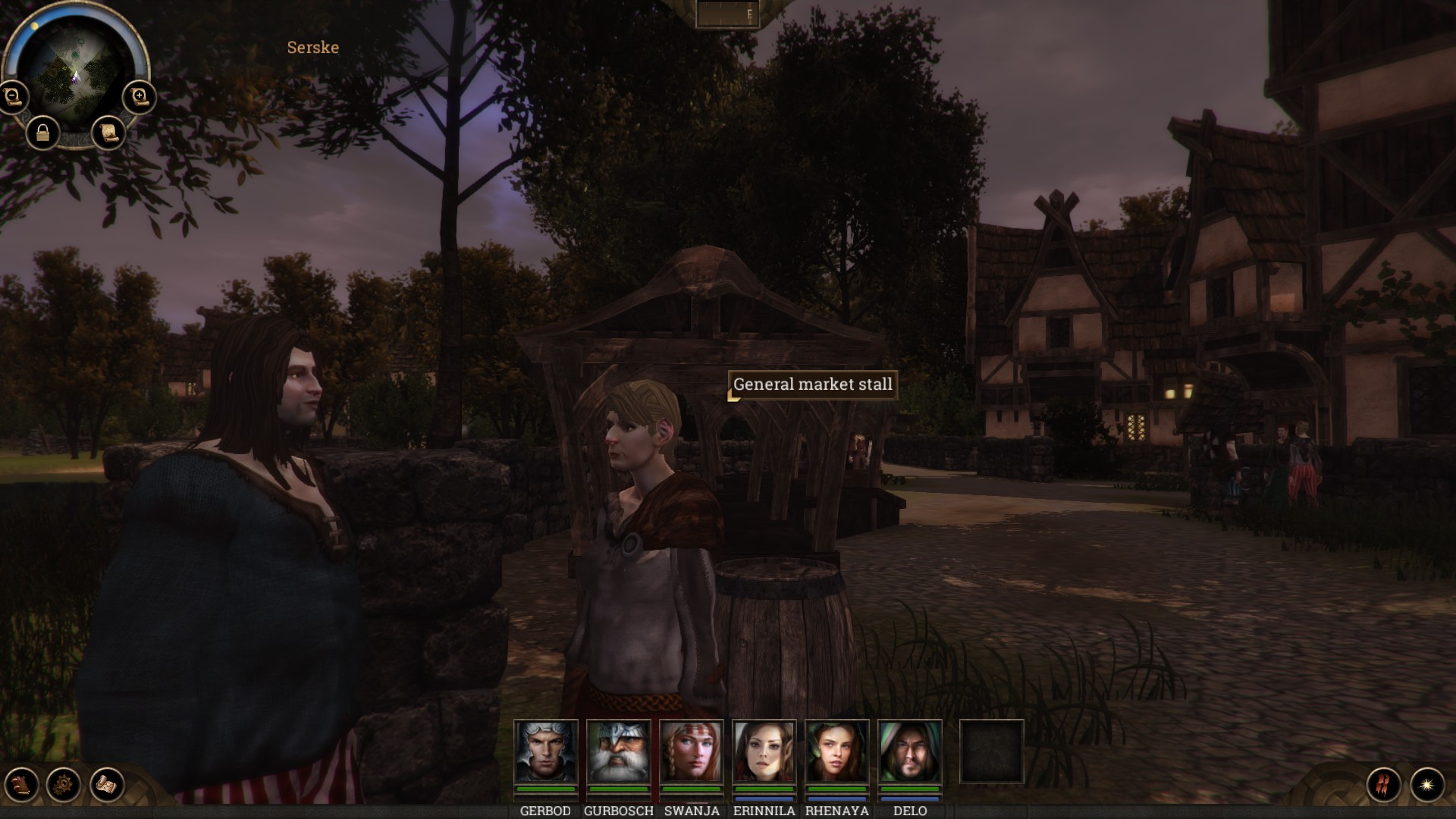
This concludes my story for now. I will go through the entire trilogy.
PS If you want to complete the game, I advise you to read the guides first, but without spoilers. Also, if you search hard, you can find a Russian translation for the game. I haven't tried it myself.
List of useful materials:
https://andrewleslie.livejournal.com/11287.html
http://mm6world.ru/a_index.htm
https://gamefaqs.gamespot.com/pc/564655-realms-of-arkania-blade-of-destiny/faqs/64921
